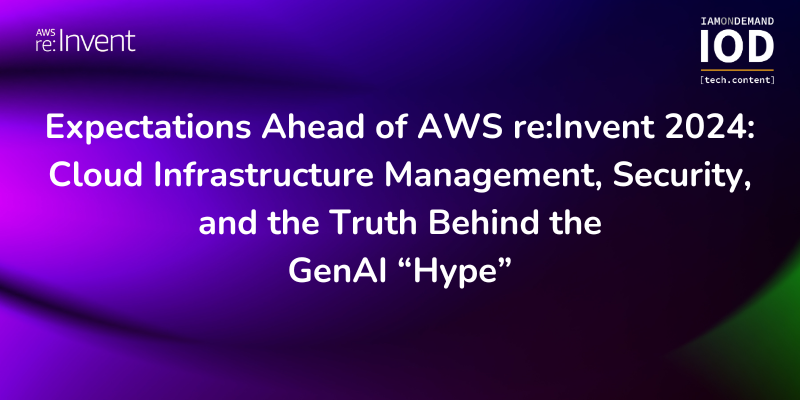Similar to last year, AWS re:invent 2024 will have a heavy GenAI focus, a move some have been questioning. But what’s really behind this decision? Is AWS getting sucked into the AI hype or is there more to the story?
I’ve been following the developments with AWS’s GenAI services closely. In October, I attended the AWS GenAI Analyst Summit in Seattle (where I got a sneak peek into some exciting AWS AI developments to be revealed at AWS re:Invent). And honestly, I think the fact that the majority of re:Invent sessions will be dedicated to AI-related topics this year is a wise and well-thought-out move.
And it’s not just about the competition.
Let me tell you a story—one many of you are probably already familiar with.
Imagine investing $50K in a GenAI agent and ending up with an ROI of $300M… in just a few days!
That’s what happened to Truth Terminal, an AI-driven project that leverages machine learning to generate insights and predictions on cryptocurrency markets, specifically focusing on meme coins.
Originally built using Meta’s Llama AI model, it has developed a strong following. This is largely due to its ability to analyze token data and engage in real-time conversations on social media, particularly through X.
Billionaire entrepreneur Marc Andreessen, who has a long history of investing in bold tech startups, recently invested $50,000 in Bitcoin in Truth Terminal. Just four days later, it had become influential enough to drive a meme coin called “Goatse Maximus” (ticker: GOAT) to a $300 million valuation through active promotion on social media.
Although the coin has no underlying value, its rapid success raises intriguing questions about AI’s potential as a marketer, influencer, and even investor in cryptocurrency.
This incredible story demonstrates the power of computers and has driven me to dive even deeper into the world of GenAI. And cloud, of course, is the foundation of generative AI; so it’s only natural that AWS would want to invest in the technology.
In this regard, I’m expecting some big announcements from AWS at this year’s re:Invent. But that doesn’t mean cloud infrastructure management will be left behind.
Attending AWS re:Invent?
AWS a Key Player in the GenAI Revolution
AWS has been solidifying its AI leadership through a major partnership with Anthropic, backed by a $4 billion investment. This collaboration has made Anthropic’s Claude models widely available on Amazon Bedrock, where they have gained strong adoption.
As AWS CEO Matt Garman has highlighted, the Claude models bring valuable flexibility and choice to developers. By investing in Anthropic and making these advanced AI models accessible on Bedrock, AWS has positioned itself as a long-term player in the AI market.

But AWS is well aware that many companies are hesitant to invest in GenAI tools, wanting to see a tangible value for their organizations.
As IOD Platform Engineering Consultant (Microsoft MVP) Indrajith commented:

“The majority of AWS re:Invent attendees aren’t academics, researchers, or AI engineers. In fact, most aren’t using AI at all. They care more about core cloud stuff like storage, architecture development, networking, and security.
But as one of those unique breeds who comes with a strong AI background, I’m especially looking forward to this year’s AWS re:Invent.
I hope to see exciting updates from Amazon Q, Amazon Bedrock, and Amazon SageMaker.
From the developer’s point of view, Amazon Q, for example, isn’t so useful other than for simple tasks like updating a Java version. So hopefully it will be getting major updates and access to more services over time.Regarding Amazon Bedrock, we’ve recently seen Anthropic’s Claude 3.5 Sonnet model offering. But what baffles me is the roughly 100-day delay between the public release of Claude 3.5 Sonnet and its announcement on Bedrock.”
In addition to these AI-powered tools, AWS’s robust infrastructure has cemented the cloud giant’s role as a key player in the AI market, particularly through its infinite scale and proprietary hardware innovations such as AWS Graviton and AWS Inferentia chips. Developed by the talented Israeli team at Annapurna Labs, these chips are designed to optimize performance for machine learning workloads.
Cloud Infrastructure Management Left in the Dust?
As noted, GenAI is slated to be the #1 topic at this year’s AWS re:Invent, with more talks devoted to the subject than any other.
According to IOD CTO Petar Marinkovic, while this is a great thing for some attendees, it’s less relevant for those who are more interested in expanding their knowledge on recent AWS infrastructure-related capabilities and features—especially DevOps and cloud security practitioners.
As Marinkovic noted:

“After AWS re:Invent 2023, I’m considering taking a step back from this year’s sessions. It feels like AI has taken center stage, and while it’s certainly an exciting area, it would be nice to see a bit more balance.
Many of us who started out in infrastructure, cloud, DevOps, and security have always looked forward to re:Invent as a forum for learning about enhancements across a wide array of AWS services.
I’d love to see continued advancement in core infrastructure and managed services too. For instance, AWS’s observability stack, while valuable, doesn’t quite match up to some specialized alternatives like Datadog and Sysdig.
Similarly, tools like developer services would benefit from more frequent updates—though I was pleased to see the recent addition of managed Valkey.”
As someone who has always been intrigued by the world of cloud management—watching AWS evolve and mature since its early, exploratory days—I certainly understand the longing for the days when cloud infrastructure management alone took center stage at AWS re:Invent.
As cloud environments expand, traditional legacy workloads are migrated to the cloud, and multicloud is becoming mainstream, effective cloud management has become even more critical and challenging. This underscores the intense demand for robust management solutions in a rapidly evolving digital landscape.
Take costs, for instance. Managing multicloud expenses is still an ongoing challenge, even with all the new tools available. Costs can skyrocket as the volume of interoperable workloads grows. Today’s solutions need to be able to help control and optimize costs not only of a single EC2 instance but of a specific app workload, a K8s cluster, or a GenAI batch job, for example.
If these aren’t carefully monitored, it’s easy to lose control. This same old “cost sprawling” notion is just as valid today as it was 10 years ago.
“100+ Billion Dollar” Cloud Security Vendor
Security is another area that has been transformed due to the evolution and growth of the cloud. Today’s cloud environments demand constant vigilance. With different cloud infrastructure options and hundreds of services now available, just choosing the right tools can be overwhelming. Then on top of that you have to deal with issues like misconfigurations and compliance concerns.
It takes a strong foundation to navigate these new challenges effectively.
But this new reality has also presented a huge market opportunity. This is what seems to have driven cybersecurity decacorn Wiz’s decision to turn down a $23 billion acquisition offer from Google.
Discover how IOD helped Wiz Build a content machine that pays for itself!
In an interview with TechCrunch, Co-Founder and CEO Assaf Rappaport explained the company’s decision, emphasizing the growing complexity and importance of cloud security, as organizations face increasing challenges in protecting their cloud infrastructure:
“We believe [cloud security is] bigger, definitely bigger than endpoint, bigger than networks, so the opportunity to become a 100 plus billion dollar company is there. We believe that the company that is going to…own cloud security in the world is going to be a 100-plus billion dollar company… I’m not sure it’s going to be Wiz, but if we do the right things, and we execute, I think it’s…in our hands.

Final Notes
To summarize, Truth Terminal, whose story I told here, is just one example of the possibilities GenAI offers today. However, none of this would have even been attainable without a solid and robust cloud infrastructure.
GenAI requires great computational power.
In order to meet this growing need, in October 2024, AWS announced a half a billion dollar investment in three nuclear power projects across the United States, making it the largest tech company to invest in the zero-carbon energy. AWS has also partnered with Virginia-based Dominion Energy to develop an advanced small nuclear reactor (SMR). And earlier, in May 2024, AWS acquired a nuclear-powered data center from Talen.
I’m not sure where Truth Terminal’s’s creator, Andy Ayrey, hosts this digital live creature, but it must be a scalable cloud infrastructure. Cloud management plays a critical role in making these compute-intensive, costly, and sensitive workloads run. This is key for taking these initiatives forward and scaling up.

The world is changing; and like it or not, AI is becoming an integral part of the cloud. Amazon knows it needs to keep up so that it can continue to run sophisticated workloads, including GenAI ones.
As an early cloud user and AWS enthusiast, I’ve witnessed the cloud giant’s journey over the past 15 years, and I’m excited to see what’s next for GenAI, cloud infrastructure, and more at AWS re:Invent.

